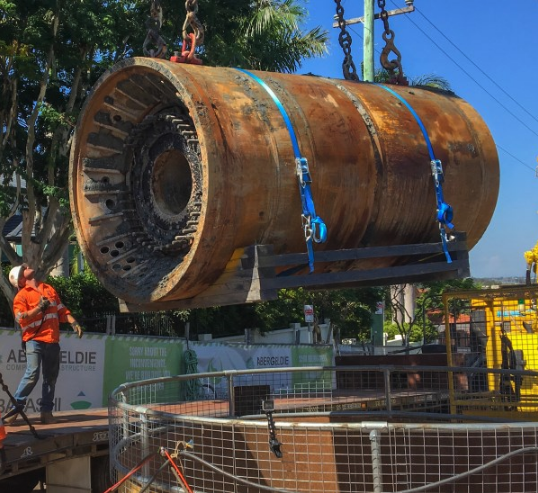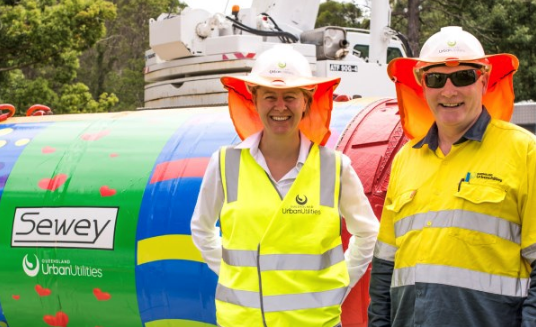Queensland Urban Utilities is nearing the end of a $55 million, 4.25km sewer in the Brisbane suburbs. The gravity-led sewer was designed too deep for standard open-cut methods, so the construction team opted for modern trenchless methods, which are becoming the standard for urban pipe works around Australia.

With the housing market growing in every major city around the country, Brisbane leads the pack, with recent estimates putting growth around 13% by 2021. Queensland Urban Utilities (QUU) is preparing for the influx with nearly $175 million worth of major water and sewerage projects currently underway around the city.
Many of these areas are dense enough that traditional trenching methods for pipe installation would create a major disruption to the local community. QUU is therefore looking to trenchless options to upgrade its systems for the next 30 to 50 years.
Queensland Urban Utilities is nearing the end of a $55 million, 4.25km sewer in the Brisbane suburbs. The gravity-led sewer was designed too deep for standard open-cut methods, so the construction team opted for modern trenchless methods, which are becoming the standard for urban pipe works around Australia.
Bulimba Creek Sewer Upgrade Stage 2
One such upgrade expected to complete before the end of 2018 is a new section of pipe in southeast Brisbane to carry wastewater from Eight Mile Plains to the Gibson Island Sewage Treatment Plant. The Bulimba Creek Sewer Upgrade Stage 2 specifically addresses restriction points in the network, augmenting it for area growth as well as mitigating the risk of wet weather overflows.
“This project is an example of how traditional methods are not practical and tunnelling is the only feasible means to construct large sewers in urban areas,” explains QUU Major Projects Manager Will Campbell.
“The alignment travels along and across major roads with residential buildings on both sides of the road.”
The project began with Stage 1 in 2004-2006, creating a high level relief sewer, followed by Stage 1a in 2009-2011, which duplicated the sewer upstream and two more downstream. The future final phase of the project will outfit the last 10km to the Gipson Island Sewage Treatment Plant.
“Stages 3 and a possible 3a are currently in a capital investment program pencilled in for 10 years or so, which need to coincide with the Gipson Island upgrade,” Campbell says.
“In a few years we’ll review growth and whether we need to push the date out or bring it forward.”
By stretching out the project over the three stages, QUU minimises cost and disruption to customers, and allows a realistic capacity upgrade on what would otherwise have been a $500-plus million project to construct more than 14km of pipeline all at once.
The trenchless option
While QUU undertook due diligence and provided a reference design, it engaged Abergeldie Constructions and Obayashi Corp as its design and construct joint venture (JV) to carry out the work.
The final route aligns down the busy thoroughfare of Scrub Road over Belmont Hill. An alternate route explored alignment along Bulimba Creek. However, this would involve working through floodplains and increasing the pipe distance to 5km.
The gravity-led sewer was designed up to 47m deep, too deep for standard open-cut methods, in order to maintain grade over the necessary distance between two existing tie-in points. QUU’s Principal Civil Engineer Scott Stevens says a trenchless solution was the obvious answer.
“We wanted to maximise drive length to the most feasible means possible,” he says. “Although a minimum internal diameter (ID) of 1.2m was required hydraulically, we decided on a 1.8m outside diameter tunnel with a 1.66m ID.
“A micro-tunnel boring machine (MTBM) was ideal for this project, with the added benefit of a hyperbaric chamber – an airlock at the back of the machine that allows access when tunnelling below the water table as a risk mitigation strategy.”
Geological challenges

Abergeldie provided the Herrenknecht AVN1500TB, a German-built, slurry shield MTBM. The machine is nearly 14m long, with a 1.8m diameter and weighs more than 45 tonnes. The JV decided it had the best capacity to tunnel through two major geological units: an abrasive argillite and a varying-strength Brisbane tuff, with the addition of some varying alluvial clay and soil deposits.
The contractor averaged 6.4m of tunnelling per shift, two shifts per day operating 23 hours, Monday to Saturday. Works progressed though hard rock at a rate of 10-12m per shift. However when soft rock and clays were encountered, progress slowed to 2-4m per shift. The team also had to factor in 650 pipe changes, with 30-45-minute interval for each pipe change. The team also chose 6m glass reinforced plastic (GRP) pipes instead of the traditional 3m pipes in order to reduce tunnelling interruptions.
Abergeldie project manager Andrew Easdale says the team was able to achieve curved drives up to 850m long, allowing fewer maintenance shafts, but not without challenges.
“The sewer is a gravity sewer with a very flat 1:1000 grade with a 30mm vertical tolerance,” Easdale explains.
“The challenge was that although the TBM operator could steer to tight tolerances, changes in the geology could cause the TBM to move out of position quite suddenly. To address this challenge, an oversized jacking pipe provided the option to construct a new invert within the pipe should any significant out of tolerance levels require it.”
Longer drives save money
Stevens says the price came down with competitive pricing, reducing the number of shafts and reconsidering the ratio of TBM size to drive length between maintenance shafts.
“Shafts are where a lot of the money goes,” Stevens says.
“The next expensive consideration is geology. Soft ground shaft construction required either sheet piling or caissons using pre-cast segments. On the other hand, shaft construction in hard rock utilised shot-crete lining and rock bolts. However the excavation through rock is painfully slow with a small machine.”
By increasing the size of the TBM, the JV was able to increase drive lengths and use curved alignments, allowing it to reduce the number of shafts.
“The alignments are the same, but the technology has improved,” Stevens observes.
“We don’t have to sink as many shafts, and as we move into the future both the technology and the competition in this space will improve what we can do.”
Get the feasibility right
Campbell says the most important part of tunnelling projects like this one is the initial feasibility and design.
“The geotechnical investigation is going to give you a good cost estimate and inform contractors before you go to market,” he says.
“It can be expensive up front, but true cost is met over a lot more criteria – disruption, time of contract, carbon footprint, for example. We engaged trenchless specialists to advise us on capabilities and suitability for application.
“Good performance criteria – what you require for the asset’s final installation – will help inform feasibility: where to locate shafts, drives alignment, impact on community, traffic, etc.”
This story was first published in the July/August edition of inspire magazine. Read the original and more here.